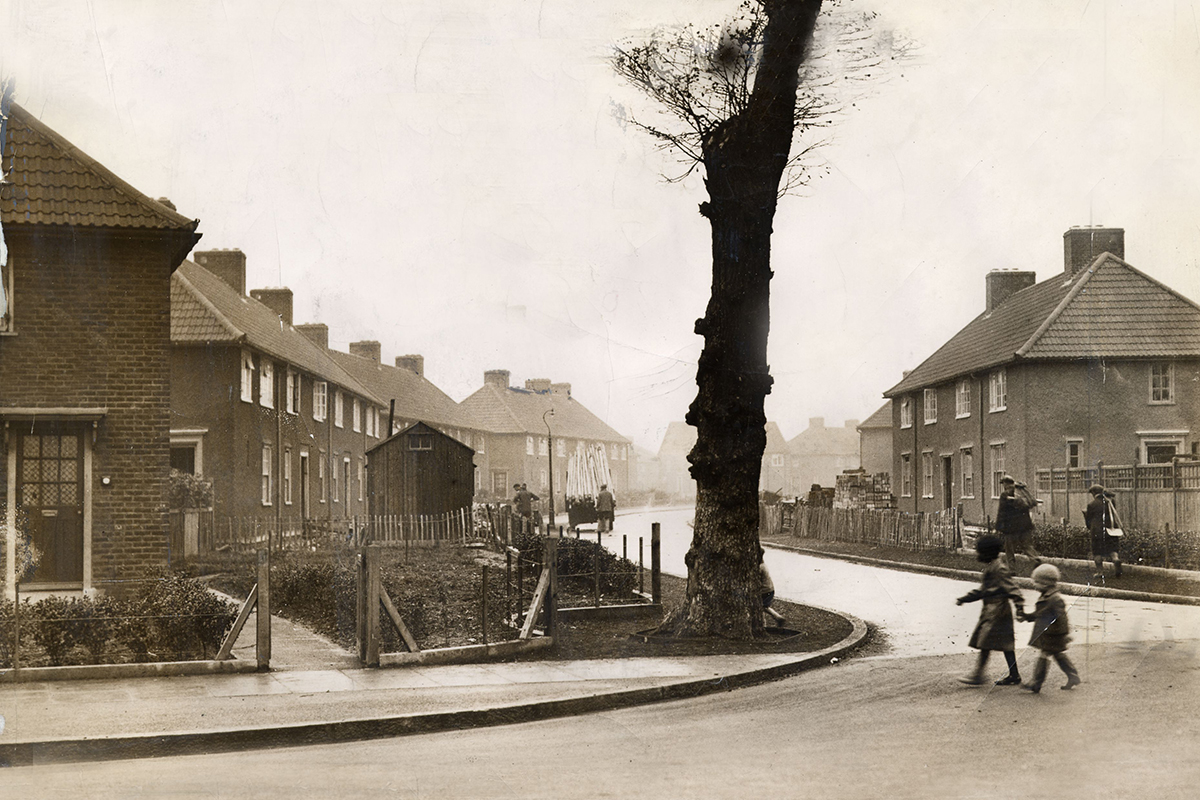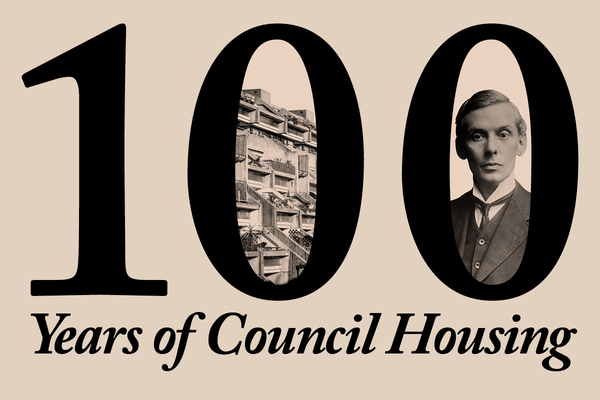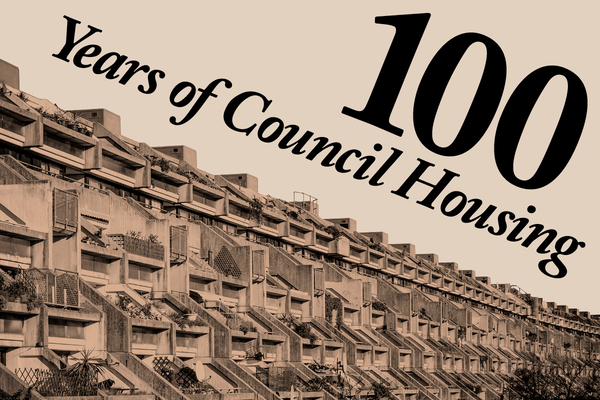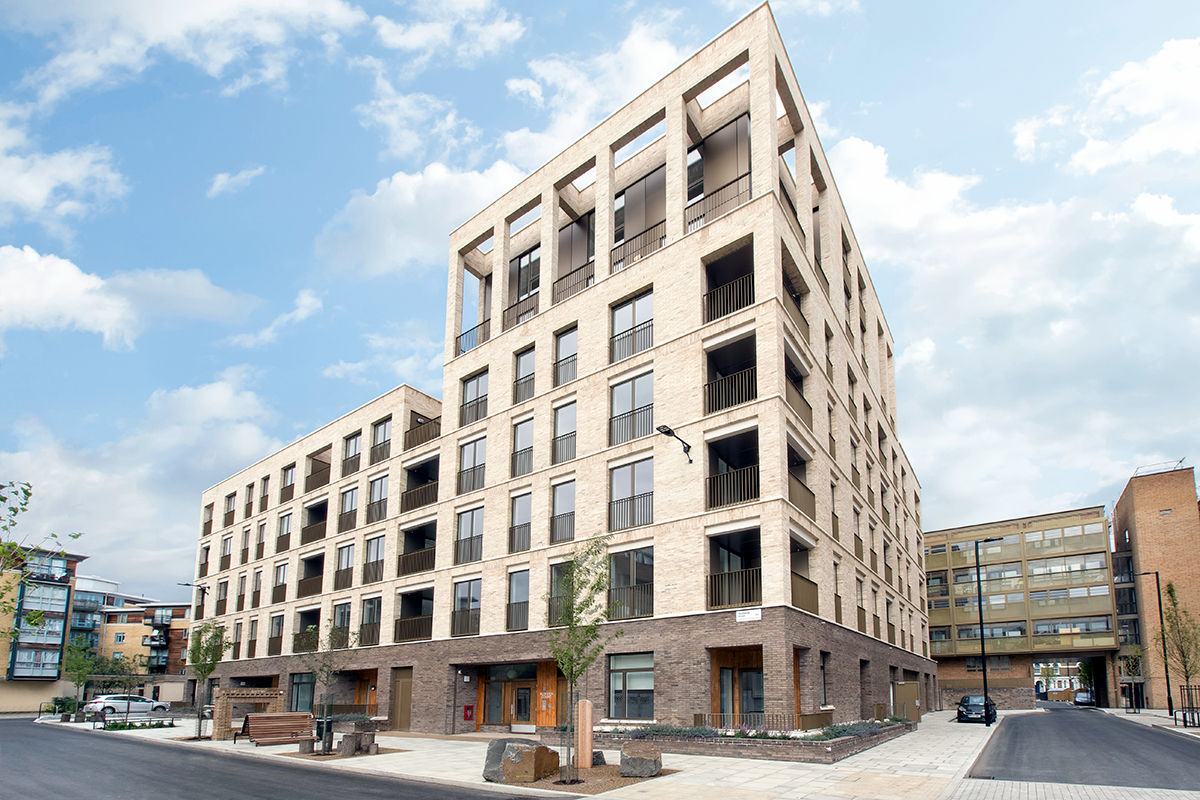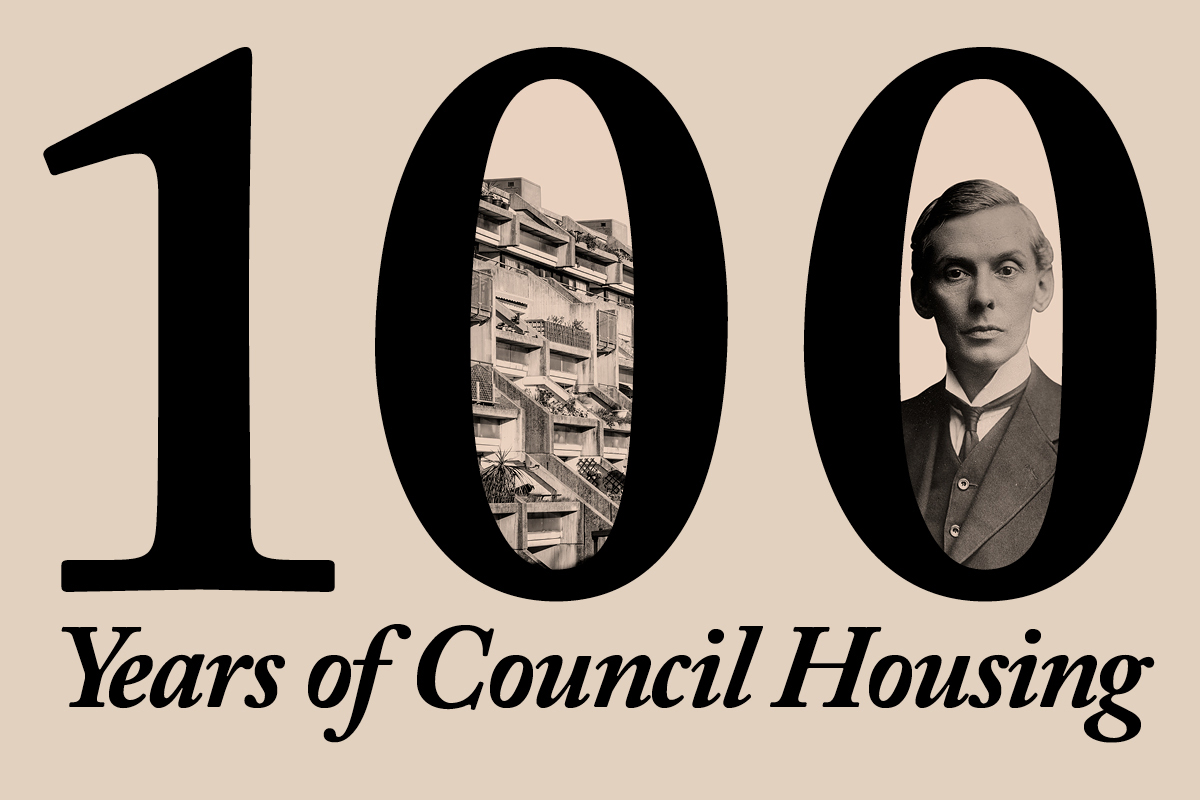You are viewing 1 of your 1 free articles
Are new borrowing freedoms sparking a revival of council housebuilding?
The Addison Act marked the birth of council housebuilding. A century later, could recent financial freedom spark a renaissance? Nathaniel Barker investigates. Pictures by Rex Features, Hackney Council and Stoke-on-Trent City Council
Inside Housing is publishing a number of articles this month to mark the 100-year anniversary of the Addison Act, which paved the way for large-scale council housebuilding.
In the aftermath of World War I, Britain was gripped by a severe housing crisis.
The problems had festered for some time, but the war brought them into stark relief. Authorities had been shocked by the sickly state of urban recruits for the trenches – and the squalid housing conditions endured by the working class were often blamed.
In 1919, parliament responded by passing the Housing and Town Planning Act, which provided vast subsidies to local authorities for the construction of good-quality homes. Today it is better known as the Addison Act, after then-minister of health Lord Christopher Addison, and is commonly recognised as the birth of British council housing.
One hundred years on, the need for quality housing in England is equally dire, with around 124,000 children sleeping in temporary accommodation and over a million people on housing waiting lists. For four decades, town halls have been restricted in their capacity to build housing. Now, with the widely despised housing borrowing cap abolished, many are returning to the fold or stepping up their ambitions.
Inside Housing looks at whether, a century on from the Addison Act, 2019 could represent the start of a new generation of municipal housebuilding.
Theresa May’s announcement at the Conservative Party conference in October that she would abolish the Housing Revenue Account (HRA) borrowing cap was warmly welcomed by councils.
Mayor of Hackney Philip Glanville called it “a huge win for campaigners and local government”. Lord Gary Porter, outgoing chair of the Local Government Association, told Inside Housing at the time that it would lead to “a renaissance in social housing”.
Nine months later, now that councils have had time to consider what a cap-free future means for them, Lord Porter stands by these comments. “I’m sticking with the level of optimism,” he says. “All of the noises I’m getting back from the sector show that people are stepping up to the plate and have started to escalate delivery.”
Definitive figures for local authority housebuilding are surprisingly difficult to come by. Different datasets return different sums, but the government’s preferred table, which only includes affordable housing, puts the figure for England at a rather paltry 3,311 homes built in 2017/18.
Ministers hope the removal of the borrowing cap will eventually see that figure rise to 10,000 a year. While such volumes would merely match the number of homes sold off through Right to Buy, it would nevertheless represent a level of development not seen since the 1980s.
It is still early days but green shoots are emerging. For instance, figures released last month
show councils are budgeting for £7.1bn of capital spending on housing in 2019/20, a 21% rise on last year, which will make housing the largest area of town hall expenditure. The figure does include spending on repairs and maintenance so some of the rise may be related to post-Grenfell fire safety works.
Ambition is one thing but delivering on it can be quite another. The Addison Act itself fell well short of its initial promises. Amid a struggling economy the funding was cut, meaning that ultimately only 213,000 homes were built under the scheme rather than the original 500,000 target.
Today a large question mark hangs over whether councils will be able to develop in significant numbers from virtually a standing start.
“The worry is we haven’t really got the internal capacity as organisations to build out at scale at the moment, because we’ve had 40 years of having it beaten out of us and nobody’s got the resources internally,” explains Lord Porter. “There is a serious issue about making sure there are enough people capable of doing it on the ground.” This does not just mean bricklayers, it means programme managers, quantity surveyors and all the other council officers required to bring sites to fruition.
There is a risk, Lord Porter says, that if councils start competing to hire the right people, the going rate will quickly become unaffordable. He believes the answer lies in joint delivery models with housing associations to take advantage of their “underutilised” capacity. In practice, this could include bringing in expertise from associations temporarily to deliver a development and then paying the organisation a profit share on the scheme, or developing through joint ventures with an agreement to share the new homes or swap existing units.
The outgoing prime minister’s decision to remove the borrowing cap was not a total bolt from the blue; it came shortly after bidding closed for a government programme offering local authorities in areas of ‘affordability pressure’ a share of £1bn in extra HRA debt headroom.
Inside Housing later revealed that the programme was massively oversubscribed, with nearly £2.9bn worth of bids flooding in from 75 councils, together promising 20,540 homes.
In turn, the £1bn came forward after several councils had approached the Ministry of Housing, Communities and Local Government over the possibility of deals to take on extra loans in return for development promises. Among the first was Stoke-on-Trent City Council, which was locked out of the £1bn programme for not meeting the unaffordability criteria.
Bridge House in Hackney, an example of modern council housebuilding
After starting to develop again in 2015, the council is set to complete its first tranche of 400 HRA homes next summer, mostly in the form of supported housing. This has been partly funded by its £30m borrowing allowance agreed as part of the local government’s self-financing settlement in 2012, as well as most of its HRA reserves, which are also around £30m.
“Now that the headroom has been lifted, it would be great to increase delivery to 250 homes a year,” says Carl Brazier, director of housing and customer services at the council. “The logic there is we lose 150 a year through the Right to Buy and we also want to eat into the waiting list of around 2,300.”
To hit those heights, Mr Brazier estimates that Stoke would need to use its new flexibilities to borrow around £125m through the HRA over five years. He adds that the council is “fairly lucky in that we’ve got land”, albeit mainly unprepped brownfield land. Other councils may find they require more borrowing in order to purchase potential sites.
If councillors do want to push ahead, Mr Brazier is sanguine about his team’s capacity to deliver. “We have already got a track record of building after we came from a standing start four years ago,” he contends. “So we have the mechanisms in place for social and affordable housing and regeneration, and we’ll be increasing those teams if elected members want to continue these suggested programmes, alongside partnerships with other organisations. I think we’re well placed and members of the team are well positioned to kick on.”
Stoke is not only looking to develop within the HRA. It also has a private housing company, Fortior Homes, and a 379-home deal with property investor Cheyne Capital. Across all these programmes, Mr Brazier reckons it has potential to directly develop 500 homes a year.
The largest bids for last year’s £1bn programme were dominated by London boroughs. However, the heftiest outside the capital came from a rather surprising quarter. Exeter City Council, with a stock of only around 4,950, threw in for a huge £102m, proposing 690 new homes during the programme’s three-year lifespan.
Councils stepping up their development plans
Barnet: 137 homes built in the past five years, 800 planned in the next 10 with £347m borrowing
Bristol: 100 homes built in the past five years, 200 a year planned for next five to 10 years with help of £43m extra borrowing
Darlington: 200 homes built since 2015, 1,000 planned over the next 10 years with help of £11.7m extra borrowing
Ealing: 550 homes built in the past 10 years, up to 300 a year planned for the next 10 with a current £100m borrowing programme
Hackney: 912 homes built in the past 10 years, up to 5,000 planned in the next 10 (Kings Crescent pictured above)
Islington: 310 homes built in past five years, 890 planned for next five with £90m extra borrowing
Leeds: 562 homes built in the past five years, 1,500 planned in the next five, including £38.1m of borrowing for next phase
Stockport: 769 homes built in past 10 years, with over 200 a year planned for next 10
Wolverhampton: 128 homes built in the past five years, 640 planned for the next five through £157m of investment
“At the time the issue was we didn’t have the security of knowing the flexibility would be there after the programme ended,” reflects Bindu Arjoon, director at Exeter Council. “With the cap lifted it means now that we have more ability to look at a programme over 10 years.”
The council is now looking at delivering 500 homes over a decade, with work about to commence on putting together a business plan. Ms Arjoon says the council is currently in conversations with Homes England about how the government agency could help Exeter assemble a development team, as well as early discussions with developers and housing associations about potential partnerships. It also established a development company last year.
With 2,000 households on its housing waiting list and around 1,000 of these in the top band, the council is aware of the desperate need for it to deliver. How it fares will be a litmus test of how well councils avail themselves of the HRA cap being scrapped.
Since returning to development in 2010, the council has delivered 67 homes over six schemes and is working on another 53 extra care flats.
A CGI of a planned council estate in Stoke-on-Trent
“We have lost ground to make up for,” remarks Laura Wright, cabinet member for council housing development and services at Exeter Council. “I see us as 30 years behind where we should be, so in that respect the 500 figure is conservative. On the other hand, it is ambitious compared to what we’ve been able to do so far.”
Ms Arjoon adds: “We’re just hoping that nothing happens that would change the existing commitment.”
With 644 homes built in the past five years and plans for 2,204 more in the next five, Hackney is one of the most active developer councils. Borough mayor Mr Glanville says the cap’s abolition means the council “can start making long-term plans”, allowing it to look towards another 2,000 in the five years after that.
Hackney already has a 60-strong in-house development team, which he is confident is up to that challenge.
However, Mr Glanville’s optimism is tempered. “There needs to be a recognition that some councils are not in the same position as Hackney,” he stresses. “Others have simply not been able to maintain delivery underneath the cap, and to see homelessness start to fall we need every council to play their part. This will be a decade-long process just to get back on track.”
As welcome as the cap’s removal is, he reasons, it can only ever be seen as part of a package that includes more grant funding, rent stability and a less onerous version of Right to Buy.
“I don’t get the impression that the Treasury is fully committed to the benefits that council housing brings,” he says. “We still don’t have that full cross-party consensus that you had 100 years ago.”
To an extent, Lord Porter appears to share these concerns. He says his own council, South Holland District Council, is still well off the pace he would like to see and emphasises the importance of councils taking advantage of their newly begotten freedoms. “Councils should be using it. It’s insane getting the flexibility and then not using it,” he says.
“It was against the Treasury’s best wishes, so we need to make sure there are more homes built so people who did trust us with it can say, ‘well, it was worth doing, because them kids are being brought up in decent, safe, secure, affordable housing’.”
With a new prime minister due to arrive, the pressure to deliver is especially pronounced, particularly as frontrunner Boris Johnson has previously been sceptical about social housebuilding. A return to the lofty ambitions of 1919 is still some way off, and there are still councils with little political inclination to get building – not to mention that around half are without an HRA.
The cap’s demise may yet prove the first step towards the resurgence of council housing, but things could easily get worse before they get better.
To read more about the act, go to: www.insidehousing.co.uk/AddisonAct
100 Years of Council Housing: we want to hear from you
To mark the 100th anniversary of the act receiving Royal Assent in July, we have a month of special activities planned, including interviews with senior council housing figures, exclusive debate and comment, and investigations into what local authorities, past and present, are doing to help provide housing.
This will signal the start of a stronger focus on local authority housing issues over the coming months on www.insidehousing.co.uk and in our weekly print and digital editions.
We want to hear from you about your local authority is doing to mark the Addison Act and about the housing issues in your area, email: editorial@insidehousing.co.uk
Sign up to receive the latest housing news straight to your inbox through our exclusive Council Focus bulletin
If you are already a subscriber click here to manage your newsletter sign-ups
Click here to read more about our activity to mark the Addison Act
100 Years of Council Housing: what Inside Housing is doing
One hundred years ago, a piece of legislation led to the birth of council housing. Gavriel Hollander introduces Inside Housing’s celebration of the centenary of the Addison Act.
It is so ingrained in our national consciousness that it is hard to imagine just how radical the idea of local authority built and funded housing must have seemed a century ago. Before World War I, almost all housing in the UK was built by private developers (albeit with some notable municipal exceptions in major cities). Given this, it is unsurprising that both quality and consistency of delivery were variable.
The post-war introduction of subsidies for councils to solve the blight of slum estates was supposed to right a wrong and – in the words of then-prime minister David Lloyd George – provide “homes fit for heroes”.
The so-called Addison Act – the very first housing act passed in this country, named after its sponsor Dr (later Lord) Christopher Addison – received royal assent exactly 100 years ago this month.
It may never have achieved its aspiration of delivering 500,000 homes (something that may sound familiar to modern-day watchers of government housing policy) but it was the start of a movement.
New estates began to crop up across the country, built in accordance with recommendations from the Tudor Walters Report, which was produced to parliament in November 1918. This built on the ‘Garden City Principles’ and suggested a number of improvements to the standard of public housing. These included limiting the length of terraced-housing blocks, mandating a minimum number of rooms and providing indoor bathrooms.
“The post-war introduction of subsidies for councils to solve the blight of slum estates was supposed to right a wrong and – in the words of the prime minister David Lloyd George – provide ‘homes fit for heroes’”
Although the abandonment of subsidy in 1921 and a change of government the following year curtailed the immediate growth of council-built housing, the seed had been sown.
This month Inside Housing celebrates the centenary of the Addison Act with a month-long series of articles looking at how it transformed the social fabric of the country and created the housing sector we know today.
Over the course of this month, we visit four estates, each symbolising a different era of council housebuilding. We also take a look at whether new-found financial freedom for local authorities could be the catalyst for a new generation of estates.
To kick off the series, acclaimed social historian John Boughton visits one of the first estates made possible by Lord Addison’s historic legislation: Sea Mills in Bristol. We then travel to Stevenage to look at how the damage to Britain’s inner cities during the Blitz led to the new town movement and a fresh wave of estates through the 1950s and 1960s.
Martin Hilditch, editor of Inside Housing, takes a trip to Hulme in Manchester to examine how the private and public sector had to work together in the 1980s to deliver a regeneration project, which is still thriving more than 30 years later.
Finally, we go to Nottingham and look at one council with grand ambitions to provide housing to a new generation of tenants.
There may still be myriad challenges to face when it comes to providing good-quality, genuinely affordable housing for those most in need, but without the passing of an act of parliament 100 years ago, the sector we work in today may never have come to exist. That alone is worth celebrating.
To read more about the act, go to: www.insidehousing.co.uk/AddisonAct
More on the Addison Act
How George Clarke is aiming to end the housing crisis with his new TV show Architect George Clarke has long been a passionate campaigner for more – and better – council housing. As Inside Housing celebrates 100 years of the Addison Act, Martin Hilditch meets a man on a mission
100 Years of Council Housing: your tweets from week three Our favourite #100yearsofcouncilhousing tweets from the past seven days as our Addison Act activity moves into its fourth week
Nottingham's new wave Robyn Wilson goes to Nottingham to see what the next generation of council homes are set to look like.
If we’re going to have another 100 years of council housing, Right to Buy has to go The Right to Buy is having a devastating effect on the availability of council housing in this country and must be scrapped, writes Lee Sugden
What next for council housing? To celebrate the centenary of the Addison Act, Inside Housing asks a group of housing experts what can be learned from its legacy (sponsored)
Thatcher's legacy: a brief history of the Right to Buy An engine for social change or a handbrake on council development? We look at why the Right to Buy is as divisive as ever #ukhousing
A history of council housing: a timeline From the Addison Act to prefabs, slum clearance and the Right to Buy, council housing in the United Kingdom has a long and colourful history. Carl Brown looks at how it has evolved over time
Council housing: the key to a more equitable and dynamic society As the 100th anniversary of the Addison Act approaches, we publish an abridged extract of a book by Chris Matthews chronicling the history of council housing in Nottingham
Addison’s framework was scrapped but its legacy is more important than ever The fortunes of council housing have ebbed and flowed ever since Addison’s programme was abruptly halted in 1921, writes Jules Birch
Hulme: the redevelopment project that changed regeneration The redevelopment of Hulme in Manchester kick-started a new approach to regeneration in the UK – and the careers of some of housing’s best-known figures. Martin Hilditch joins them on a step back in time with lessons for today.
100 Years of Council Housing: your tweets from week two We pick our favourite #100yearsofcouncil housing tweets over the past week
Memories of council housing: the human legacy of the Addison Act As the centenary of the first council houses approaches, Peter Apps hears from some of the people who have lived in them in the decades since
Many of the sector’s current leaders began their journeys in council teams One hundred years of council housing has delivered a generation of sector leaders as well as millions of council homes, writes Mervyn Jones
Stevenage: home of the new town revolution Stevenage was the first of the post-war ‘new towns’. Gavriel Hollander visits the town to see how it has changed.
100 Years of Council Housing: your tweets from week one Inside Housing has been encouraging councils to say what they are doing to build homes and to mark 100 years of council housing. Here we feature a selection of your tweets
Kit Malthouse: 'Council housing is coming back with a vengeance' Housing minister Kit Malthouse tells Martin Hilditch why growing numbers of councils are looking to get back into development
Sea Mills: we visit one of the first estates to benefit from the Addison Act Social historian John Boughton visits a place in Bristol still cherished today
The Housing Podcast: is council housebuilding about to make a comeback Nearly 100 years after the introduction of the Addison Act, which kick-started the building of the first council estates in the UK, the Housing Podcast team examines the state of council housebuilding today
Why the 100th anniversary of the Addison Act should spark a council housing comeback Let’s make 2019 the start of a renaissance of council housing, writes Martin Hilditch
Are new borrowing freedoms sparking a revival of council housebuilding? The Addison Act marked the birth of council housebuilding. A century later, could recent financial freedom spark a renaissance? Nathaniel Barker investigates.
How Cornwall is taking inspiration from Christopher Addison Cornwall Council is one of many keeping the legacy alive, writes Kate Kennally.
The Addison Act - celebrating 100 years of council housing This year marks the 100th anniversary of the Addison Act – which paved the way for council housebuilding on a large scale. Inside Housing has a whole month of special activity planned and we want to hear your stories
The 100-year anniversary of the Addison Act means it’s time to talk about council housing Let’s use the 100th anniversary of council housing as we know it to flag up some of the great work that’s been done – and kick-start a conversation about the future, writes Martin Hilditch
London must recapture the housebuilding ambition of the Addison Act Councils are committed to development but are still facing unfair restrictions, writes Darren Rodwell of London Councils
Marking 100 years since the ‘Addison Act’ Professor Mark Swenarton writes about the Homes Fit for Heroes Centenary Conference
More council news
Council tenants on Universal Credit 16 times more likely to abandon tenancies
Council to claw back 260 Right to Buy homes
Local authorities accuse government of ‘sleight of hand’ over post-Hackitt regulation
Partner with housing associations to use borrowing freedoms, says LGA chair
Bristol City Council signs off partnership with L&G for 500-home scheme
Council boss warns against local authority ‘can't do’ attitude towards housebuilding
Right to Buy sales plummet 23%
Supreme Court rules against Birmingham Council in homelessness case
A bed every night: has Manchester's mayor succeeded in helping every rough sleeper in the city?
Council housing company to offer Rent to Buy
Council-owned regeneration company to build 500 homes
How has Haringey Council moved on from its development vehicle fight?
Liverpool to open HRA to build new council homes for first time in 30 years
How can London councils build more homes?
Birmingham Council’s housing company to build 2,708 homes by 2029
How are councils are using pension funds to build homes
